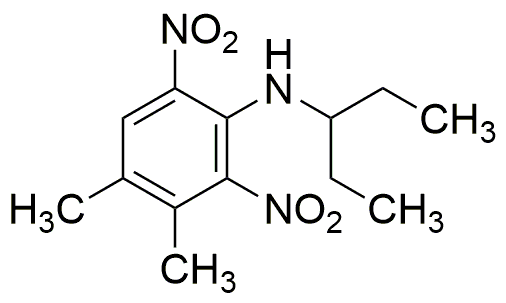Pendimethalin is widely utilized in research focused on:
- Agricultural Herbicide: Primarily used in crop production, it effectively controls a variety of annual grasses and broadleaf weeds, enhancing crop yield and quality.
- Environmental Studies: Researchers use it to study soil and water contamination, assessing its impact on ecosystems and developing remediation strategies.
- Integrated Pest Management: Pendimethalin is incorporated into pest management programs, helping to reduce reliance on more toxic chemicals and promoting sustainable agriculture.
- Plant Growth Regulation: It is used in studies examining its effects on plant growth and development, providing insights into herbicide resistance and plant responses.
- Formulation Development: The chemical serves as a key ingredient in developing new herbicide formulations, allowing for improved efficacy and reduced environmental impact compared to older products.
General Information
Properties
Safety and Regulations
Applications
Pendimethalin is widely utilized in research focused on:
- Agricultural Herbicide: Primarily used in crop production, it effectively controls a variety of annual grasses and broadleaf weeds, enhancing crop yield and quality.
- Environmental Studies: Researchers use it to study soil and water contamination, assessing its impact on ecosystems and developing remediation strategies.
- Integrated Pest Management: Pendimethalin is incorporated into pest management programs, helping to reduce reliance on more toxic chemicals and promoting sustainable agriculture.
- Plant Growth Regulation: It is used in studies examining its effects on plant growth and development, providing insights into herbicide resistance and plant responses.
- Formulation Development: The chemical serves as a key ingredient in developing new herbicide formulations, allowing for improved efficacy and reduced environmental impact compared to older products.
Documents
Safety Data Sheets (SDS)
The SDS provides comprehensive safety information on handling, storage, and disposal of the product.
Product Specification (PS)
The PS provides a comprehensive breakdown of the product’s properties, including chemical composition, physical state, purity, and storage requirements. It also details acceptable quality ranges and the product's intended applications.
Certificates of Analysis (COA)
Search for Certificates of Analysis (COA) by entering the products Lot Number. Lot and Batch Numbers can be found on a product’s label following the words ‘Lot’ or ‘Batch’.
*Catalog Number
*Lot Number
Certificates Of Origin (COO)
This COO confirms the country where the product was manufactured, and also details the materials and components used in it and whether it is derived from natural, synthetic, or other specific sources. This certificate may be required for customs, trade, and regulatory compliance.
*Catalog Number
*Lot Number
Safety Data Sheets (SDS)
The SDS provides comprehensive safety information on handling, storage, and disposal of the product.
DownloadProduct Specification (PS)
The PS provides a comprehensive breakdown of the product’s properties, including chemical composition, physical state, purity, and storage requirements. It also details acceptable quality ranges and the product's intended applications.
DownloadCertificates of Analysis (COA)
Search for Certificates of Analysis (COA) by entering the products Lot Number. Lot and Batch Numbers can be found on a product’s label following the words ‘Lot’ or ‘Batch’.
*Catalog Number
*Lot Number
Certificates Of Origin (COO)
This COO confirms the country where the product was manufactured, and also details the materials and components used in it and whether it is derived from natural, synthetic, or other specific sources. This certificate may be required for customs, trade, and regulatory compliance.


